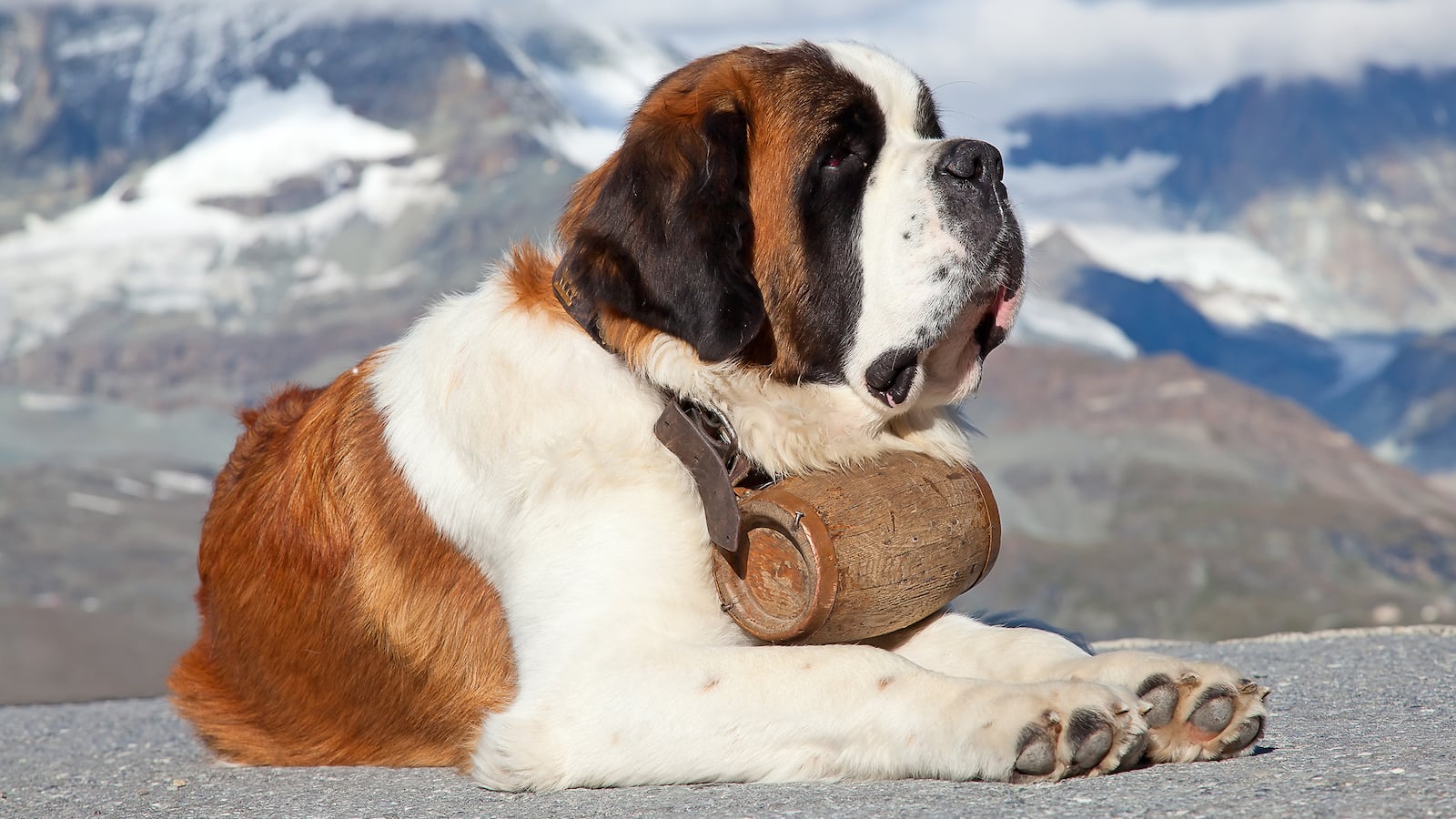The first known instance of a St. Bernard bearing a neck cask rescuing a person in peril took place in 1820. Contrary to popular belief, this didn’t occur in the snowy Alps. It was in England, probably in an art studio. Because the first instance was wholly a matter of artistic fancy—a pair of St. Bernards, then called Alpine mastiffs, were depicted saving a haggard man, his life draining from him as he lay entombed in a snowbank. One dog is evidently signaling rescuers by barking. The other dog compassionately licks the man’s hand, perhaps trying to warm it enough that he might twist the spigot on the tiny barrel affixed around its neck, and partake of life-giving brandy.
The artwork, entitled Alpine Mastiffs Reanimating a Distressed Traveler, was painted by a prodigy named Edwin Landseer. At the time, he was just 17 years old, and it was said he could paint with both hands simultaneously. (Dog’s head with the left; tail with the right; meet in the middle. One imagines Bob Ross on methamphetamines.) Landseer had never been to the Alps, but some years earlier he’d seen a stellar example of one of these dogs, which had crossed the Channel for a British tour. The mastiff made a memorable impression on Landseer.
Landseer would go on to become a noted painter of animals of many stripes, especially dogs and horses. (Among his favored scenes were Newfoundland dogs saving the drowning.) In fact, his work was notable enough that he palled around with Charles Dickens and William Makepeace Thackeray later in life, and also became a favorite of Queen Victoria. (The queen noted of him that he was “very good looking although rather short.”)
But his most influential painting arguably was one of his first—the depiction of the heroic St. Bernards. It was this work that ensured that henceforth everyone would associate certain dogs with certain tiny barrels.
Many tall stories contain a shot-glass worth of truth, and that appears to be the case in the matter of rescue dogs. In fact, a western Alpine pass did exist that vexed travelers, connecting modern-day Italy and Switzerland. The pass had earlier been a shortcut for rampaging Romans heading north, who had erected a temple to Jupiter there. More than a millennium later, the pass was used by devout Catholic pilgrims headed south to Rome. Short, but often dangerous. Snow persisted year-round, and could drift up to 40 feet. Avalanches were common. And so, Bernard of Menthon (ca. 1020-1081), later St. Bernard, erected a traveler’s shelter and monastery at the highest point, about 8,000 feet above sea level.
The origin story involving the dogs is murkier. Accounts suggest that in the late 1600s the dogs were brought in as watch dogs by the monks manning the pass. Hounds were depicted in a painting by an Italian artist in 1695; the first written mention of these dogs at the monastery (“A dog was buried by us”) was recorded in 1707.
These were broad-chested cattle dogs probably first brought north by the Romans, and meant to keep cow herds safe. They were soon recognized as also having superior search and rescue skills. With their powerful muscles, thick winter coats and keen sense of smell, the dogs were well suited to finding those who’d wandered astray into the endless drifts, and were further bred to find and aid disoriented mountain travelers caught in blizzards and avalanches.
Among the most famed of the pack was a dog named “Barry der Menschenretter” (1800-1814), who is credited with saving 40 travelers gone astray. This included a young boy near-frozen in an ice cave, whom Barry licked back to warmth, and then brought home on his back. Or so lore says. After a productive career, Barry retired to Bern. In his honor, the monks have kept one dog named Barry ever since, although most rescues are now relegated to helicopters.
The St. Bernards—as they were officially designated by the Swiss Kennel Club in 1880—could find the lost by scent, and revive them by licking or laying atop them like a lumpy but warm comforter. What they could not do was slake one’s thirsty or revive one with a stiff drink. No historic account has the dogs traipsing about with small casks of brandy, and that’s probably for good reason. Alcohol prompts dilation in the blood vessels, which gives the impression of surface warmth on the skin, but at the grievous cost of reduced core temperature. Ergo, for hikers stranded on a snowy slope brandy would accelerate death. The idea of having a beast offer brandy is like rescuing a burn victim with a keg of lighter fluid and a book of matches.
The artist who invented the barrel-toting St. Bernard, Landseer, had a prominent but somewhat unhappy later career. He suffered from nervous breakdowns, and, according to The Victorian Web, “after 1870 sank slowly into madness,” which indeed sounds quite Victorian. He died in 1873, a national hero—flags were flown at half-staff, and the lions at the base of Nelson’s Column were festooned with wreaths.
But the greatest memorial to the artist may be the persistence of the myth of the St. Bernard and its keg of brandy. The well-established connection between the two continues to live on more than a century after Landseer’s demise, with slobbery dogs and their casks posing for picture in the Swiss Alps, and barrel-toting dogs making cameos in advertisements for just about anything tangentially involved with Switzerland.
For its part, the St. Bernard Rescue Society does not take a position on dogs and brandy barrels. Rather it seeks refuge in the sort of “some say” journalism embraced by beginning reporters everywhere. Historians say no barrels were involved, the society notes, although “others disagree.” If you are among the dissenters, you are invited to purchase “a quality hand-crafted wooden keg with harness” to support the society’s work. It can be yours for $85 and needs to be filled with your brandy of choice.





